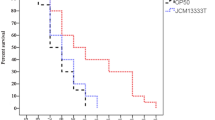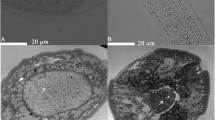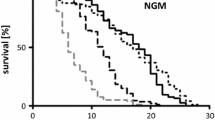Abstract
Colonization resistance is an important attribute for bacterial interactions with hosts, but the mechanism is still not completely clear. In this study, we found that Phytobacter sp. SCO41T can effectively inhibit the in vivo colonization of Bacillus nematocida B16 in Caenorhabditis elegans, and we revealed the colonization resistance mechanism. Three strains of colonization-resistant bacteria, SCO41T, BX15, and BC7, were isolated from the intestines of the free-living nematode C. elegans derived from rotten fruit and soil. The primary characteristics and genome map of one of the three isolates was investigated to explore the underlying mechanism of colonization resistance in C. elegans. In addition, we performed exogenous iron supplementation and gene cluster knockout experiments to validate the sequencing results. The results showed that relationship was close among the three strains, which was identified as belonging to the genus Phytobacter. The type strain is SCO41T (= CICC 24103T = KCTC 52362T). Whole genome analysis showed that csgA, csgB, csgC, csgE, csgF, and csgG were involved in the curli adhesive process and that fepA, fepB, fepC, fepD, and fepG played important roles in SCO41T against the colonization of B. nematocida B16 in C. elegans by competing for iron. Exogenous iron supplementation showed that exogenous iron can increase the colonization of B. nematocida B16, which was additionally confirmed by a deletion mutant strain. The csg gene family contributes to the colonization of SCO41T in C. elegans. Curli potentially contribute to the colonization of SCO41T in C. elegans, and enterobactin has a key role in SCO41T to resist the colonization of B. nematocida B16 by competing for iron.







Similar content being viewed by others
Data availability
The data sets supporting the results of this article are included within the article.
References
Woodmansey EJ (2007) Intestinal bacteria and ageing. J Appl Microbiol 102:1178–1186
Gerritsen J, Smidt H, Rijkers GT, de Vos WM (2011) Intestinal microbiota in human health and disease: the impact of probiotics. Genes Nutr 6:209–240
Yano JM, Yu K, Donaldson GP et al (2015) Indigenous bacteria from the gut microbiota regulate host serotonin biosynthesis. Cell 161:264–276
Xiao Y, Liu F, Zhang Z (2016) Retraction notice to: gut-colonizing bacteria promote C. elegans innate immunity by producing nitric oxide. Cell Rep 15:1123
Zhang YJ, Li S, Gan RY et al (2015) Impacts of gut bacteria on human health and diseases. Int J Mol Sci 16:7493–7517
Marie-Anne F, Fabien D (2012) Population dynamics and habitat sharing of natural populations of Caenorhabditis elegans and C. briggsae. BMC Biol 10:59. https://doi.org/10.1186/1741-7007-10-59
Filipe C, David G (2013) Worms need microbes too: microbiota, health and aging in Caenorhabditis elegans. Embo Mol Med 5:1300–1310
Macneil L, Watson E, Efsun Arda H et al (2013) Diet-Induced developmental acceleration independent of TOR and insulin in Caenorhabditis elegans. Cell 153:240–252
Ikeda T, Yasui C, Hoshino K, Arikawa K, Nishikawa Y (2007) Influence of lactic acid bacteria on longevity of Caenorhabditis elegans and host defense against salmonella enterica serovar enteritidis. Appl Environ Microbiol 73:6404
Montalvo-Katz S, Huang H, Appel MD, Berg M, Shapira M (2013) Association with soil bacteria enhances p38-dependent infection resistance in Caenorhabditis elegans. Infection immunity 81:514–520
Buffie CG, Pamer EG (2013) Microbiota-mediated colonization resistance against intestinal pathogens. Nat Rev Immunol 13:790–801
Britton RA, Young VB (2014) Role of the intestinal microbiota in resistance to colonization by Clostridium difficle. Gastroenterology 146:1547
Momose Y, Hirayama K, Itoh K (2008) Competition for proline between indigenous Escherichia coli and E. coli O157:H7 in gnotobiotic mice associated with infant intestinal microbiota and its contribution to the colonization resistance against E. coli O157:H7. Antonie Van Leeuwenhoek 94:165–171
Kamada N, Kim YG, Sham HP, Vallance BA, Puente JL, Martens EC, Núñez G (2012) Regulated virulence controls the ability of a pathogen to compete with the gut microbiota. Science 336:1325–1329
Patzer SI1, Baquero MR, Bravo D, Moreno F, Hantke K (2003) The colicin G, H and X determinants encode microcins M and H47, which might utilize the catecholate siderophore receptors FepA, Cir, Fiu and IroN. Microbiology 149:2557–2570
Unterweger D, Miyata ST, Bachmann V et al (2014) The Vibrio cholerae type VI secretion system employs diverse effector modules for intraspecific competition. Nat Commun 5:3549
Johansson ME, Ambort D, Pelaseyed T et al (2011) Composition and functional role of the mucus layers in the intestine. Cell Mol Life Sci 68:3635–3641
Hasegawa M, Kamada N, Jiao Y et al (2012) Protective role of commensals against Clostridium difficile infection via an IL-1β-mediated positive-feedback loop. J Immunol 189:3085
Atarashi K, Tanoue T, Oshima K et al (2013) Treg induction by a rationally selected mixture of Clostridia strains from the human microbiota. Nature 500:232–236
Huang X, Tian B, Niu Q, Yang J, Zhang L, Zhang K (2005) An extracellular protease from Brevibacillus laterosporus G4 without parasporal crystals can serve as a pathogenic factor in infection of nematodes. Res Microbiol 156:719–727
Niu QH, Huang X, Hui F et al (2012) Colonization of Caenorhabditis elegans by Bacillus nematocida B16, a bacterial opportunistic pathogen. J Mol Microbiol Biotechnol 22:258–267
Niu Q, Zhang L, Zhang K et al (2016) Changes in intestinal microflora of Caenorhabditis elegans following Bacillus nematocida B16 infection. Sci Rep 6:20178. https://doi.org/10.1038/srep20178
Niu Q, Zheng H, Zhang L et al (2015) Knockout of the adp gene related with colonization in Bacillus nematocida B16 using customized transcription activator-like effectors nucleases. Microb Biotechnol 8:681–692
Pavan ME, Franco RJ, Rodriguez JM, Gadaleta P, Abbott SL, Janda JM, Zorzópulos J (2005) Phylogenetic relationships of the genus Kluyvera: transfer of Enterobacter intermedius Izard et al. 1980 to the genus Kluyvera as Kluyvera intermedia comb. nov. and reclassification of Kluyvera cochleae as a later synonym of K. intermedia. Int J Syst Evol Microbiol 55:437–442
Blom J, Kreis J, Spänig S, Juhre T, Bertelli C, Ernst C, Goesmann A (2016) EDGAR 2.0: an enhanced software platform for comparative gene content analyses. Nucleic Acids Res 44:22–28
Pillonetto M, Arend LN, Faoro H et al (2017) Emended description of the genus Phytobacter, its type species Phytobacter diazotrophicus (Zhang 2008) and description of Phytobacter ursingii sp. nov. Int J Syst Evol Microbiol 68:176–184
Weinberg ED (2009) Iron availability and infection. Biochim Biophys Acta 1790:600–605
Braun V, Hantke K (2011) Recent insights into iron import by bacteria. Curr Opin Chem Biol 15:328–334
Ramanan D, Bowcutt R, Lee SC et al (2016) Helminth infection promotes colonization resistance via type 2 immunity. Science 352:608–612
Miller CP, Bohnoff M, Rifkind D (1956) The effect of an antibiotic on the susceptibility of the mouse’s intestinal tract to Salmonella infection. Trans Am Clin Climatol Assoc 68:51–55
Rendueles O, Kaplan J, Ghigo JM (2013) Antibiofilm polysaccharides. Environ Microbiol 15:334–346
Römling U, Sierralta WD, Eriksson K, Normark S (1998) Multicellular and aggregative behaviour of Salmonella typhimurium strains is controlled by mutations in the agfD promoter. Mol Microbiol 28:249–264
Chapman MR, Robinson LS, Pinkner JS et al (2002) Role of Escherichia coli curli operons in directing amyloid fiber formation. Science 295:851–855
Hammer ND, Schmidt JC, Chapman MR (2007) The curli nucleator protein, CsgB, contains an amyloidogenic domain that directs CsgA polymerization. Proc Natl Acad Sci USA 104:12494–12499
Wang X, Chapman MR (2008) Sequence determinants of bacterial amyloid formation. J Mol Biol 380:570–580
Bokranz W, Wang X, Tschäpe H, Römling U (2005) Expression of cellulose and curli fimbriae by Escherichia coli isolated from the gastrointestinal tract. J Med Microbiol 54:1171–1182
Carter MQ, Brandl MT, Louie JW et al (2011) Distinct acid resistance and survival fitness displayed by curli variants of enterohemorrhagic Escherichia coli O157:H7. Appl Environ Microbiol 77:3685–3695
Macarisin D, Patel J, Bauchan G, Giron J, Sharma V (2012) Role of curli and cellulose expression in adherence of Escherichia coli O157:H7 to spinach leaves. Foodborne Pathog Dis 9:160–167
Saldaña Z, Xicohtencatl-Cortes J, Avelino F et al (2009) Synergistic role of curli and cellulose in cell adherence and biofilm formation of attaching and effacing Escherichia coli and identification of Fis as a negative regulator of curli. Environ Microbiol 11:992–1006
Kai-Larsen Y, Lüthje P, Chromek M et al (2010) Uropathogenic Escherichia coli modulates immune responses and its curli fimbriae interact with the antimicrobial peptide LL-37. PLoS Pathog 6:e1001010
Olsén A, Jonsson A, Normark S (1989) Fibronectin binding mediated by a novel class of surface organelles on Escherichia coli. Nature 338:652–655
Bian Z, Brauner A, Li Y, Normark S (2000) Expression of and cytokine activation by Escherichia coli curli fibers in human sepsis. J Infect Dis 181:602–612
Kikuchi T, Mizunoe Y, Takade A, Naito S, Yoshida S (2005) Curli fibers are required for development of biofilm architecture in Escherichia coli K-12 and enhance bacterial adherence to human uroepithelial cells. Microbiol Immunol 49:875–884
Dertz EA, Xu J, Stintzi A, Raymond KN (2006) Bacillibactin-mediated iron transport in Bacillus subtilis. J Am Chem Soc 128:22–23
Walsh CT, Liu J, Rusnak F, Sakaitani M (1990) Molecular studies on enzymes in chorismate metabolism and the enterobactin biosynthetic pathway. Chem Rev 90:1105–1129
Raymond KN, Dertz EA, Kim SS (2003) Enterobactin: an archetype for microbial iron transport. Proc Natl Acad Sci USA 100:3584–3588
Orchard SS, Rostron JE, Segall AM (2012) Escherichia coli enterobactin synthesis and uptake mutants are hypersensitive to an antimicrobial peptide that limits the availability of iron in addition to blocking Holliday junction resolution. Microbiology 158:547–559
Li B, Li N, Yue Y et al (2016) An unusual crystal structure of ferric-enterobactin bound FepB suggests novel functions of FepB in microbial iron uptake. Biochem Biophys Res Commun 478:1049–1053
Deriu E, Liu JZ, Pezeshki M et al (2013) Probiotic bacteria reduce Salmonella Typhimurium intestinal colonization by competing for iron. Cell Host Microbe 14:26–37
Nagy TA, Moreland SM, Andrewspolymenis H, Detweiler CS (2013) The ferric enterobactin transporter Fep is required for persistent Salmonella enterica serovar typhimurium infection. Infect Immun 81:4063–4070
Acknowledgements
This work was supported by the projects from the National Natural Science Foundation Program of the People’s Republic of China (Grant Nos. 31770138, 31570120 31100104 and 31870917) and by program for Science & Technology Innovation Talents in Universities of Henan province, HASTIT (Grant No. 17HASTIT041) and by the fund of Scientific and Technological research project of Henan province (Grant No. 182102110084).
Author information
Authors and Affiliations
Contributions
QHN and LGY conceived and designed the experiments. BWW and BFH performed the bacterial isolation and the final genome assembly, analyzed the genome annotation. JMC and WPL carried out the characterizations and classification of the bacterial strains. LY coordinated the sequence analysis and the drafted the manuscript. LGY, QHN, BWW, and BFH participated in the verification experiments, and helped draft the manuscript. All authors read and approved the final manuscript.
Corresponding authors
Ethics declarations
Conflict of interest
The authors declare that there is no conflict of interest that could be perceived as prejudicing the impartiality of the research reported. The funders had no role in study design, data collection and analysis, decision to publish, or preparation of the manuscript.
Additional information
Publisher’s Note
Springer Nature remains neutral with regard to jurisdictional claims in published maps and institutional affiliations.
Electronic supplementary material
Below is the link to the electronic supplementary material.
Rights and permissions
About this article
Cite this article
Wang, B., Huang, B., Chen, J. et al. Whole-genome analysis of the colonization-resistant bacterium Phytobacter sp. SCO41T isolated from Bacillus nematocida B16-fed adult Caenorhabditis elegans. Mol Biol Rep 46, 1563–1575 (2019). https://doi.org/10.1007/s11033-018-04574-w
Received:
Accepted:
Published:
Issue Date:
DOI: https://doi.org/10.1007/s11033-018-04574-w




